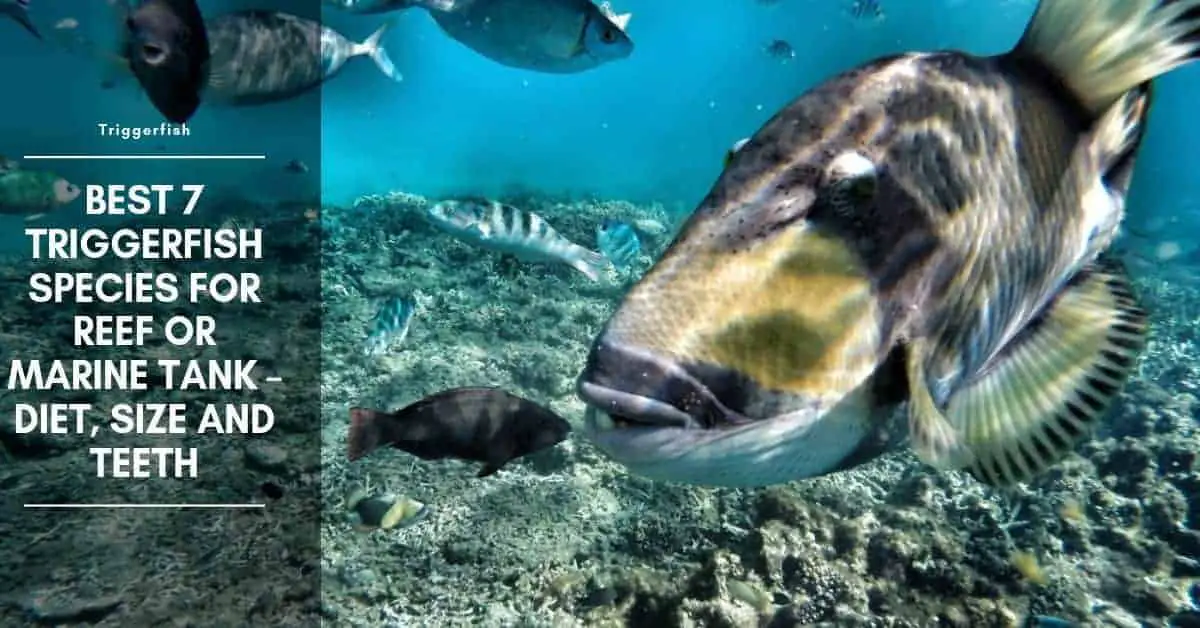A relatively stocky, oval body shape characterizes reef triggerfish. Their caudal fins are quite small, so these types of triggerfish rely mainly on the rippling movement of the rear part of their dorsal fin, combined with their anal fin, to propel themselves through the water.
Their front dorsal spine interlocks with a smaller second spine and can be used to anchor the fish in a rocky crevice. Once the locking mechanism has been triggered, it is virtually impossible to dislodge them.
It may be necessary to buy a reef triggerfish in its chosen retreat, should it seek sanctuary there while being caught. Triggerfish are ideal for those seeking a fish with a “personality”. They can be tamed sufficiently to feed on hand-offered items and they are a great addition to your reef or marine tank.
List of Triggerfish Types
Niger Triggerfish
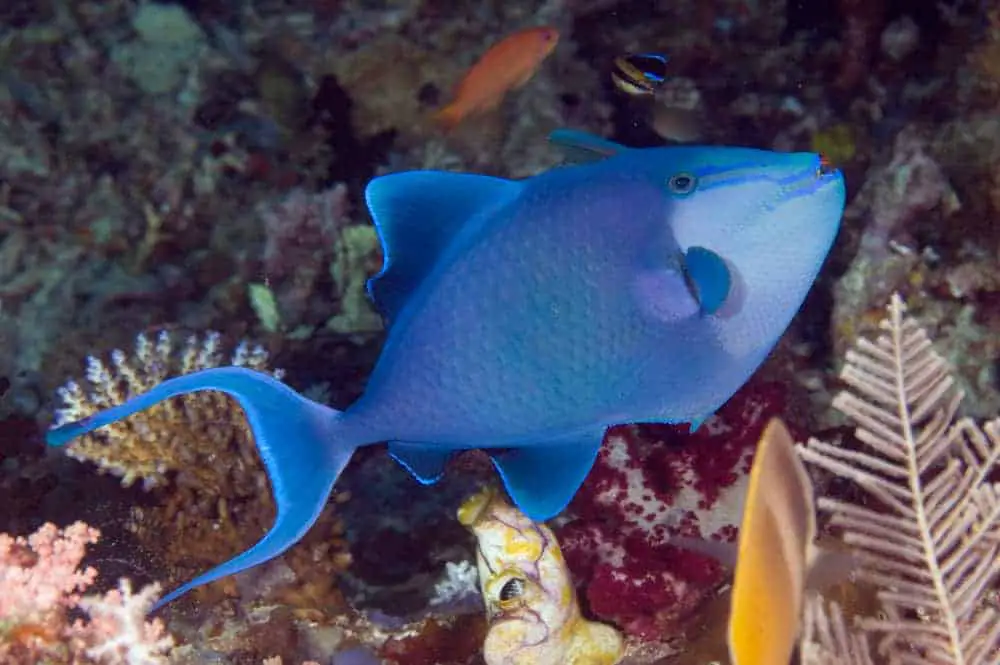
- ORIGINS From the Red Sea eastward, through the Pacific to Japan and Australia’s Great Barrier Reef.
- SIZE 16 in (40 cm).
- DIET Animal-based foods, including shrimp.
- WATER Temperature 77–79°F (25–26°C); alkaline (pH 8.2–8.4) with SG 1.023–1.027
- TEMPERAMENT Placid.
These triggerfish are equipped with a formidable array of red teeth at the front of their mouths. The body color varies throughout their range, from a bluish hue to green. It can also be affected by their mood. Despite their scientific name (niger means “black”), these fish are never black.
When danger threatens, they usually swim head-first into a suitable reef crevice. Adequate retreats must be therefore included in the tank.
Blueline Triggerfish
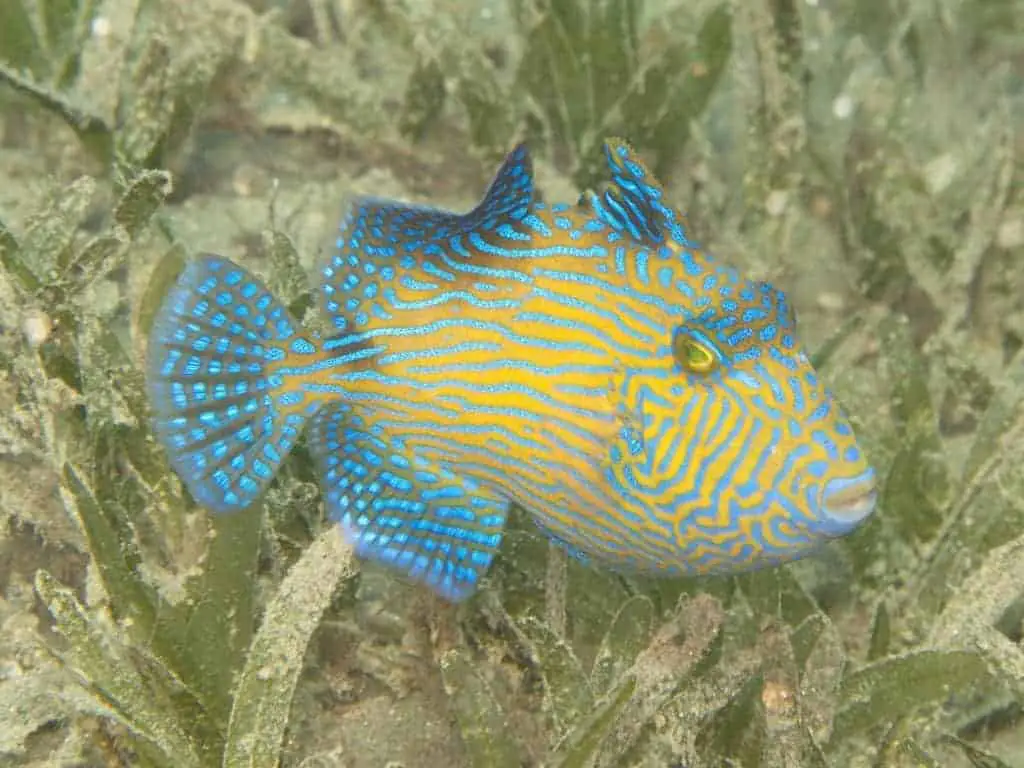
- ORIGINS From East Africa and the Red Sea through the Pacific to Samoa and Micronesia.
- SIZE 22 in (56 cm).
- DIET Fish and invertebrates.
- WATER Temperature 77–79°F (25–26°C); alkaline (pH 8.2–8.4) with SG 1.023–1.027.
- TEMPERAMENT Unpredictable and always territorial
Tough and hardy, these fish typify the requirements of triggerfish.
They need to be kept singly, because they will prey on smaller fish, and generally do not like the company of their own kind. Blueline Triggerfish can also be very destructive within the aquarium, since they dig in the substrate, and must not be housed with invertebrates.
API STRESS COAT Aquarium Water Conditioner 16-Ounce Bottle
Tetra AquaSafe Plus, 8.45 Ounces, aquarium Water Conditioner And Dechlorinator, Model Number: 46798162681
$10.19 (as of December 14, 2025 08:19 GMT +03:00 - More infoProduct prices and availability are accurate as of the date/time indicated and are subject to change. Any price and availability information displayed on [relevant Amazon Site(s), as applicable] at the time of purchase will apply to the purchase of this product.)API TAP WATER CONDITIONER Aquarium Water Conditioner 16-Ounce Bottle
$8.48 (as of December 14, 2025 08:19 GMT +03:00 - More infoProduct prices and availability are accurate as of the date/time indicated and are subject to change. Any price and availability information displayed on [relevant Amazon Site(s), as applicable] at the time of purchase will apply to the purchase of this product.)Picasso Triggerfish
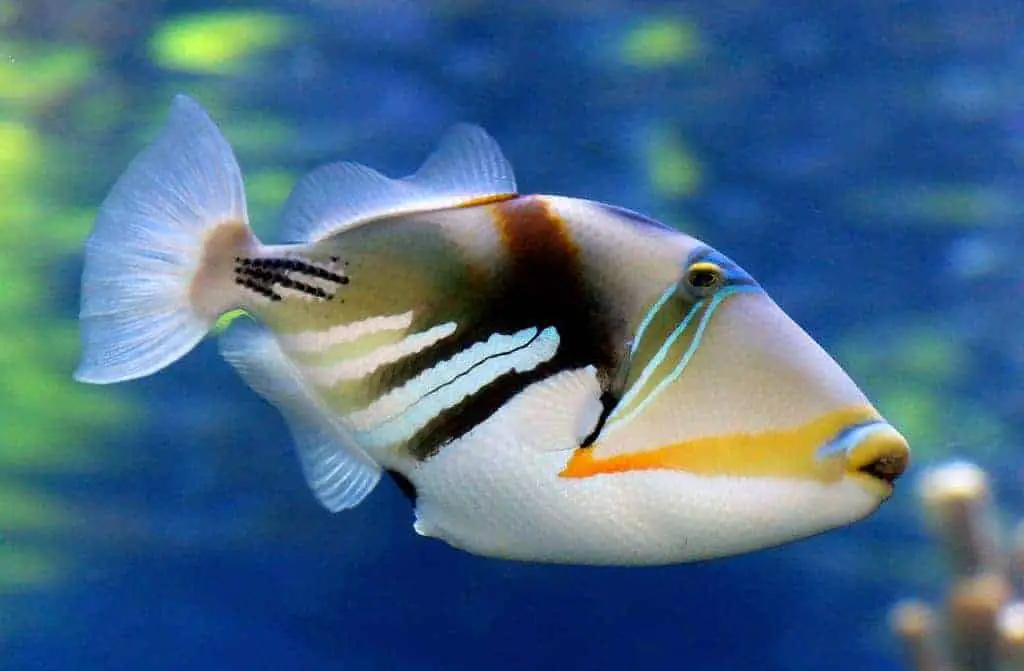
- ORIGINS From East Africa throughout the Indo-Pacific region to Japan and Hawaii.
- SIZE 10 in (25 cm).
- DIET Fish and animal-based foods.
- WATER Temperature 77–79°F (25–26°C); alkaline (pH 8.2–8.4) with SG 1.023–1.027.
- TEMPERAMENT Territorial.
Patterned like an abstract painting, the Picasso Triggerfish has yellow markings along the sides of its face, suggesting that the jaws can open wide. In reality, however, the mouth is small, as in other triggerfish.
The Picasso’s pelvic fins are reduced to a small projection under the body, and it is a slow, slightly clumsy swimmer. This triggerfish often grunts, especially when being caught.
Clown Triggerfish

- ORIGINS From East Africa through the Pacific to Japan, Samoa, and the eastern side of Australia.
- SIZE 20 in (50 cm).
- DIET Animal-based foods.
- WATER Temperature 77–79°F (25–26°C); alkaline (pH 8.2–8.4) with SG 1.023–1.027.
- TEMPERAMENT Not to be trusted with other fish.
Clown Triggerfish is unmistakable. The pattern effectively conceals the eyes of this fish, so disorienting potential predators.
The dorsal fin is split into two separate parts, with the darker front portion often being folded down into a groove running along the back. An aquarium for this and other triggerfish should include caves to which the fish can retire at night.
Boomerang Triggerfish
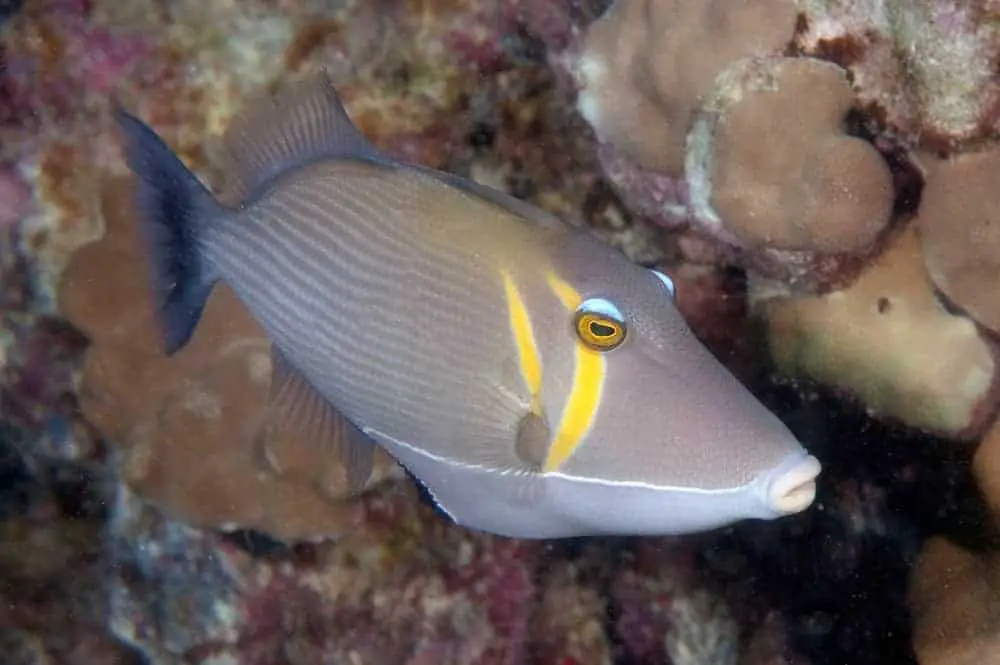
- ORIGINS Widely distributed throughout the Indo-Pacific region.
- SIZE 10 in (25 cm).
- DIET Omnivorous; very easy to feed.
- WATER Temperature 77–79°F (25–26°C); alkaline (pH 8.2–8.4) with SG 1.023–1.027.
- TEMPERAMENT Antisocial.
Pale body, largely transparent fins, and two stripes on each side of the head identify this triggerfish. Males are more brightly colored than females.
Like related species, the Triggerfish is relatively tolerant in terms of water quality, but it needs an aquarium to itself. Start out with a lively juvenile of about 4 in (10 cm), which will be easier to tame. Young Triggerfish grow at a surprisingly fast rate.
Orange-Lined Triggerfish
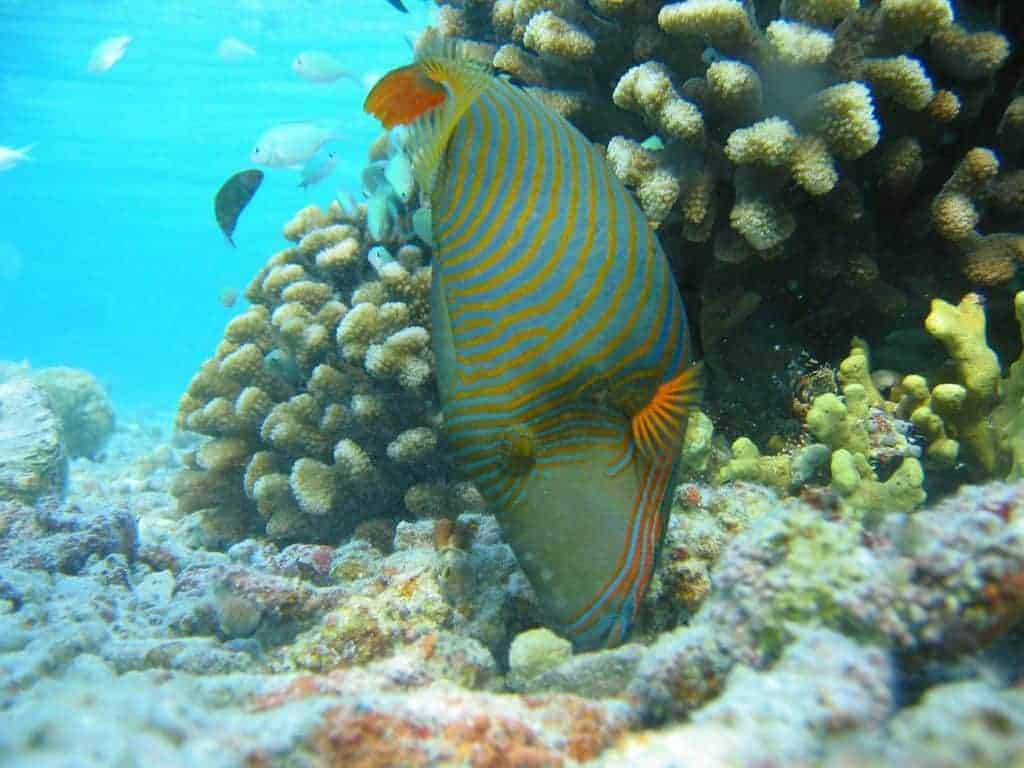
- ORIGINS The Indo-Pacific region, although it does not extend as far as Hawaii.
- SIZE 12 in (30 cm)
- DIET A range of animal foods, including river shrimp.
- WATER Temperature 77–79°F (25–26°C); alkaline (pH 8.2–8.4) with SG 1.023–1.027.
- TEMPERAMENT One of the most aggressive triggerfish.
In the Orange-Lined Triggerfish of the Pacific, shown below, the caudal fin is yellow-green, but in Indian Ocean specimens it is orange. One of the appealing features of triggerfish is their eyes, which move independently.
When anchoring themselves in a crevice, triggerfish may inflate their bodies slightly, although not as much as puffer fish.
Queen Triggerfish
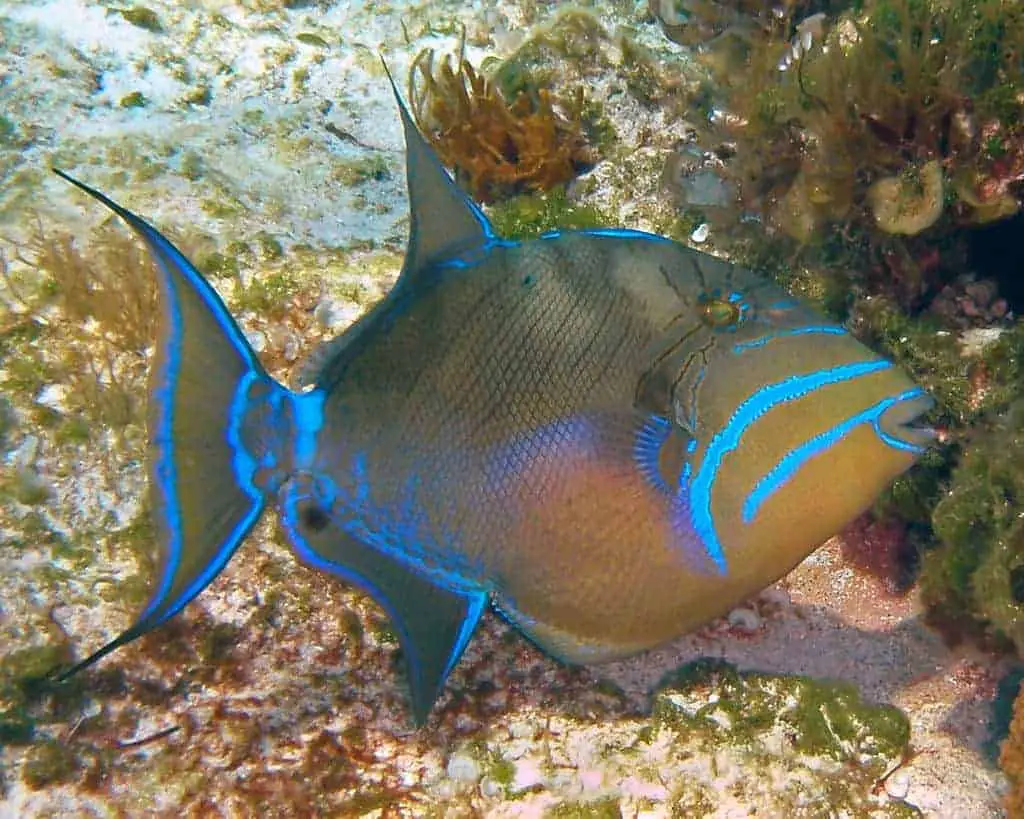
- ORIGINS Found through tropical parts of the western Atlantic, typically in Caribbean waters.
- SIZE Up to 20 in (50 cm); 10 in (25 cm) in aquariums.
- DIET Fish and invertebrates.
- WATER Temperature 77–79°F (25–26°C); alkaline (pH 8.2–8.4) with SG 1.023–1.027.
- TEMPERAMENT Antisocial.
These large, attractive triggerfish are relatively easy to care for since they feed on a variety of meat-based foods and do not need company. Unfortunately, their reproductive habits rule outbreeding in the home aquarium.
In the wild, the larger and more colorful male mates with several females in turn. The females then guard their eggs in individual spawning pits until they hatch, even to the extent of biting divers who come too close.
Triggerfish Teeth
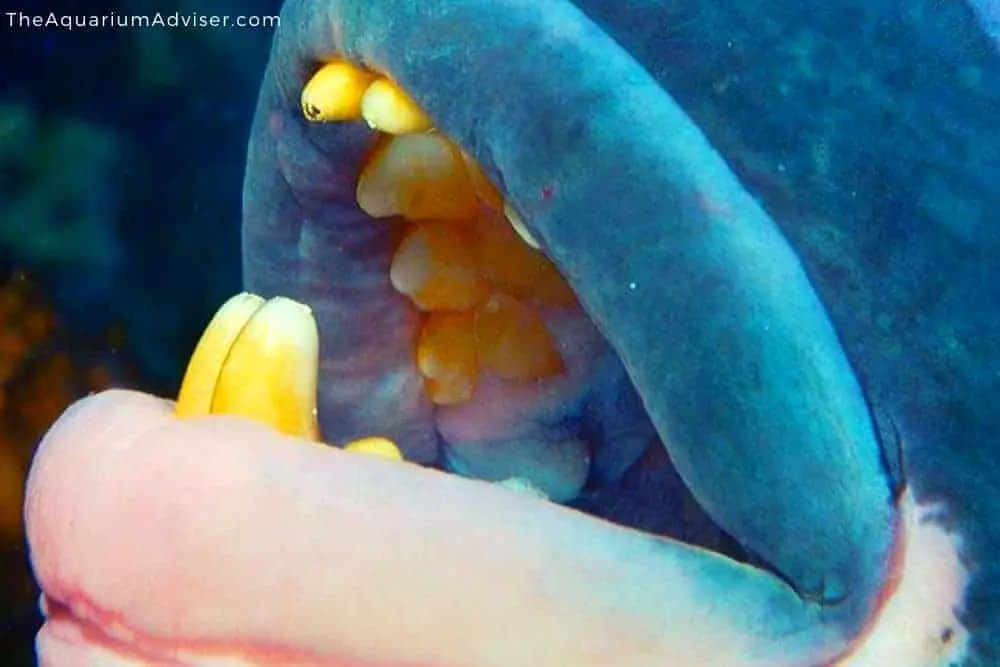
In the wild, triggerfish rely on their powerful teeth to crush the shells of crustaceans, mollusks, and even coral, which they eat. They also communicate by grinding their teeth.
Triggerfish Bite
Although triggerfish have small mouths, their powerful jaws have rows of teeth that can inflict a very painful bite. Take particular care when offering food directly, and always feed the fish before you put your hands into the tank to service it.
A triggerfish is even capable of biting through the heater cable in the aquarium – electrocuting itself as a consequence – so protect cabling accordingly.

Hi, my name is Sean, and I’m the primary writer on the site. I’m blogging mostly about freshwater and saltwater aquariums, fish, invertebrates, and plants. I’m experienced in the fishkeeping hobby for many years. Over the years I have kept many tanks, and have recently begun getting more serious in wanting to become a professional aquarist. All my knowledge comes from experience and reading forums and a lot of informative sites. In pursuit of becoming a professional, I also want to inspire as many people as I can to pick up this hobby and keep the public interest growing.
Read more about Sean.
Please join also my Facebook group.

